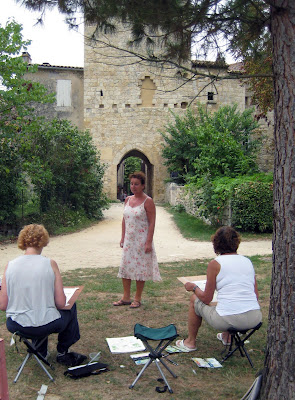

Dear Martin or Steven,
I know you're both sitting next to your telephones just waiting for me to ring. Unfortunately I've lost your private contact numbers, so here's the information you've been waiting for.
A film script of my novel "Coup de Grace" will be available in book form later this year - or early in 2010.
But in this three act adaption, many changes have been made, firstly from the precise screenplay format that is required by you film industry professionals - and secondly to the story line which has been fundamentally modified.

The most important of these alterations is the ending. I felt the need to change this quite dramatically for a film script, in order to make it more visual - and it now has a completely different denouement from the one in the book.
I only realized afterwards of course, that once you take a hatchet to a novel with the intention of removing large chunks of it, there are many unforeseeable consequences.
For one, the story went off in a different direction, and this required the elimination of several major and minor characters who appear in the novel, as well as many of the incidents that I had used in an attempt to create the ‘spirit of place’ in France before, during and after the two World Wars.
However, when this was done, some holes were left in the narrative, and I immediately saw that I now needed to
add several new scenes, and introduce a few
more characters, both for continuity and to propel the story forward.
At this time, I also became interested in the ‘heroic’ nature of survival, and some of the traits of the two main characters have been swapped.
I hope the result of these alterations will make this version more readable for those not associated with the movie industry.
I have been working on the novel and the screen versions of Coup de Grâce ever since I arrived in France ten years ago. The idea first came to me when I stumbled across a roadside memorial near my home in a small town in Gascony. It marks the spot where a young boy was shot by the departing Germans a few months before the war ended, and I felt perturbed that such barbarity could have taken place in this idyllic part of France just over sixty years ago.
But a glance at the headlines or TV news on any day will remind everyone that this kind of savage act is still endemic throughout the world.
Although this book is a work of fiction, everything (well almost) is based on actual events. It is graphic and crude and violent, and it contains, I hope, not a jot of romanticism.
Several of the incidents were described to me by older French people I have met - some are taken from descriptions I have found in resistance museums and on war memorials - and others are from books, magazine and newspaper reports I have rooted out.
The twin themes of the story are, I suppose, collaboration and resistance. These are complicated issues, and there were many shades of both. For those of us - like me - who have never lived in an occupied country, they can be especially difficult ideas to unravel. But through some of the fictionalized events described, I hope I have been able to provide an insight into how complex and dangerous the dark years of Nazi occupation were for the people of France.
However, although my sympathies are categorically and wholeheartedly with the French, it would be folly for anyone to believe that evil attaches itself exclusively to one side in any conflict.
In war there are no winners, and in Coup de Grâce, good does not triumph over evil - the price for treachery is seldom exacted - and brutality is meted out equally on both sides in the struggle for Liberation.
Without belaboring the point, I hope the unrelenting anti-war theme, as well as the idea that prejudice is universal, both come through loud and clear.
Finally, I must add the warning that this play based on my novel, and it will not be to everyone’s taste. Strong language is common in the dialogue, some of the characters express decidedly anti establishment views, and there are several graphic sexual scenes that some readers may find offensive.
But I guess you've both used a bit of all of these elements in most of your movies.
Please go to my website to find out where to send the thousands you're going to offer me for this script.
Gros bisous.Ray






















































